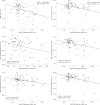Synergistic effects of ischemia and β-amyloid burden on cognitive decline in patients with subcortical vascular mild cognitive impairment
- PMID: 24554306
- PMCID: PMC5849078
- DOI: 10.1001/jamapsychiatry.2013.4506
Synergistic effects of ischemia and β-amyloid burden on cognitive decline in patients with subcortical vascular mild cognitive impairment
Abstract
Importance: Cerebrovascular disease (CVD) and Alzheimer disease are significant causes of cognitive impairment in the elderly. However, few studies have evaluated the relationship between CVD and β-amyloid burden in living humans or their synergistic effects on cognition. Thus, there is a need for better understanding of mild cognitive impairment (MCI) before clinical deterioration begins.
Objective: To determine the synergistic effects of β-amyloid burden and CVD on cognition in patients with subcortical vascular MCI (svMCI).
Design, setting, and participants: A cross-sectional study was conducted using a hospital-based sample at a tertiary referral center. We prospectively recruited 95 patients with svMCI; 67 of these individuals participated in the study. Forty-five patients with amnestic MCI (aMCI) were group matched with those with svMCI by the Clinical Dementia Rating Scale Sum of Boxes.
Main outcomes and measures: We measured β-amyloid burden using positron emission tomography with carbon 11-labeled Pittsburgh Compound B (PiB). Cerebrovascular disease was quantified as white matter hyperintensity volume detected by magnetic resonance imaging fluid-attenuated inversion recovery. Detailed neuropsychological tests were performed to determine the level of patients' cognitive impairment.
Results: On evaluation, 22 of the svMCI group (33%) and 28 of the aMCI group (62%) were found to be PiB positive. The mean PiB retention ratio was lower in patients with svMCI than in those with aMCI. In svMCI, the PiB retention ratio was associated with cognitive impairments in multiple domains, including language, visuospatial, memory, and frontal executive functions, but was associated only with memory dysfunction in aMCI. A significant interaction between PiB retention ratio and white matter hyperintensity volume was found to affect visuospatial function in patients with svMCI.
Conclusions and relevance: Most patients with svMCI do not exhibit substantial amyloid burden, and CVD does not increase β-amyloid burden as measured by amyloid imaging. However, in patients with svMCI, amyloid burden and white matter hyperintensity act synergistically to impair visuospatial function. Therefore, our findings highlight the need for accurate biomarkers, including neuroimaging tools, for early diagnosis and the need to relate these biomarkers to cognitive measurements for effective use in the clinical setting.
Conflict of interest statement
Figures



Similar articles
-
Blood viscosity in subcortical vascular mild cognitive impairment with versus without cerebral amyloid burden.J Stroke Cerebrovasc Dis. 2014 May-Jun;23(5):958-66. doi: 10.1016/j.jstrokecerebrovasdis.2013.08.004. Epub 2014 Feb 28. J Stroke Cerebrovasc Dis. 2014. PMID: 24589034
-
Cortical thickness and hippocampal shape in pure vascular mild cognitive impairment and dementia of subcortical type.Eur J Neurol. 2014 May;21(5):744-51. doi: 10.1111/ene.12376. Epub 2014 Feb 4. Eur J Neurol. 2014. PMID: 24495089 Free PMC article.
-
Amyloid and cerebrovascular burden divergently influence brain functional network changes over time.Neurology. 2019 Oct 15;93(16):e1514-e1525. doi: 10.1212/WNL.0000000000008315. Epub 2019 Sep 11. Neurology. 2019. PMID: 31511349
-
Associations between amyloid-β load and cognition in cerebrovascular disease beyond cerebral amyloid angiopathy: a systematic review and meta-analysis of positron emission tomography studies.Age Ageing. 2024 Oct 1;53(10):afae240. doi: 10.1093/ageing/afae240. Age Ageing. 2024. PMID: 39468728
-
Vascular Cognitive Impairment.Continuum (Minneap Minn). 2024 Dec 1;30(6):1699-1725. doi: 10.1212/CON.0000000000001508. Continuum (Minneap Minn). 2024. PMID: 39620840 Review.
Cited by
-
Comparison of Longitudinal Changes of Cerebral Small Vessel Disease Markers and Cognitive Function Between Subcortical Vascular Mild Cognitive Impairment With and Without NOTCH3 Variant: A 5-Year Follow-Up Study.Front Neurol. 2021 Feb 25;12:586366. doi: 10.3389/fneur.2021.586366. eCollection 2021. Front Neurol. 2021. PMID: 33716917 Free PMC article.
-
Consensus statement for diagnosis of subcortical small vessel disease.J Cereb Blood Flow Metab. 2016 Jan;36(1):6-25. doi: 10.1038/jcbfm.2015.172. J Cereb Blood Flow Metab. 2016. PMID: 26198175 Free PMC article. Review.
-
Role of amyloid peptides in vascular dysfunction and platelet dysregulation in Alzheimer's disease.Front Cell Neurosci. 2015 Mar 3;9:65. doi: 10.3389/fncel.2015.00065. eCollection 2015. Front Cell Neurosci. 2015. PMID: 25784858 Free PMC article. Review.
-
Neuroimaging criteria and cognitive performance in vascular mild cognitive impairment: A systematic review.Dement Neuropsychol. 2015 Oct-Dec;9(4):394-404. doi: 10.1590/1980-57642015DN94000394. Dement Neuropsychol. 2015. PMID: 29213989 Free PMC article.
-
The association of white matter hyperintensities with motoric cognitive risk syndrome.Cereb Circ Cogn Behav. 2022 Aug 25;3:100150. doi: 10.1016/j.cccb.2022.100150. eCollection 2022. Cereb Circ Cogn Behav. 2022. PMID: 36324398 Free PMC article.
References
-
- Frisoni GB, Galluzzi S, Bresciani L, Zanetti O, Geroldi C. Mild cognitive impairment with subcortical vascular features: clinical characteristics and outcome. J Neurol. 2002;249(10):1423–1432. - PubMed
-
- O’Brien JT, Erkinjuntti T, Reisberg B, et al. Vascular cognitive impairment. Lancet Neurol. 2003;2(2):89–98. - PubMed
-
- Wentzel C, Rockwood K, MacKnight C, et al. Progression of impairment in patients with vascular cognitive impairment without dementia. Neurology. 2001;57(4):714–716. - PubMed
-
- Seo SW, Cho SS, Park A, Chin J, Na DL. Subcortical vascular versus amnestic mild cognitive impairment: comparison of cerebral glucose metabolism. J Neuroimaging. 2009;19(3):213–219. - PubMed
-
- Seo SW, Ahn J, Yoon U, et al. Cortical thinning in vascular mild cognitive impairment and vascular dementia of subcortical type. J Neuroimaging. 2010;20(1):37–45. - PubMed
Publication types
MeSH terms
Substances
Grants and funding
LinkOut - more resources
Full Text Sources
Other Literature Sources
Medical

